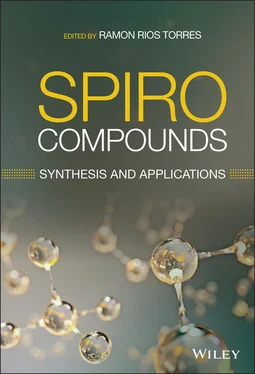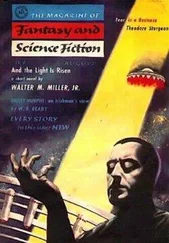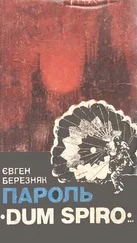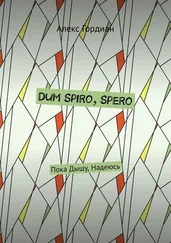Spiro Compounds
Здесь есть возможность читать онлайн «Spiro Compounds» — ознакомительный отрывок электронной книги совершенно бесплатно, а после прочтения отрывка купить полную версию. В некоторых случаях можно слушать аудио, скачать через торрент в формате fb2 и присутствует краткое содержание. Жанр: unrecognised, на английском языке. Описание произведения, (предисловие) а так же отзывы посетителей доступны на портале библиотеки ЛибКат.
- Название:Spiro Compounds
- Автор:
- Жанр:
- Год:неизвестен
- ISBN:нет данных
- Рейтинг книги:3 / 5. Голосов: 1
-
Избранное:Добавить в избранное
- Отзывы:
-
Ваша оценка:
- 60
- 1
- 2
- 3
- 4
- 5
Spiro Compounds: краткое содержание, описание и аннотация
Предлагаем к чтению аннотацию, описание, краткое содержание или предисловие (зависит от того, что написал сам автор книги «Spiro Compounds»). Если вы не нашли необходимую информацию о книге — напишите в комментариях, мы постараемся отыскать её.
A comprehensive treatment of the latest research in, and applications of, spiro compounds Spiro Compounds: Synthesis and Applications
Spiro Compounds
Spiro Compounds — читать онлайн ознакомительный отрывок
Ниже представлен текст книги, разбитый по страницам. Система сохранения места последней прочитанной страницы, позволяет с удобством читать онлайн бесплатно книгу «Spiro Compounds», без необходимости каждый раз заново искать на чём Вы остановились. Поставьте закладку, и сможете в любой момент перейти на страницу, на которой закончили чтение.
Интервал:
Закладка:
48 48 Carreira, E.M. and Fessard, T.C. (2014). Four‐membered ring‐containing spirocycles: synthetic strategies and opportunities. Chem. Rev. 114 (16): 8257–8322.
49 49 Baell, J.B. and Holloway, G.A. (2010). New substructure filters for removal of pan assay interference compounds (PAINS) from screening libraries and for their exclusion in bioassays. J. Med. Chem. 53 (7): 2718–2740.
50 50 Reboul, M. (1878). Oxyde de Propylene Normal et Polyoxypropylenes. Ann. Chim. (Paris) 14: 495–497.
51 51 Bull, J.A., Croft, R.A., Davis, O.A. et al. (2016). Oxetanes: recent advances in synthesis, reactivity, and medicinal chemistry. Chem. Rev. 116 (19): 12150–12233.
52 52 Ringnér, B., Sunner, S., and Watanabe, H. (1971). The enthalpies of combustion and formation of some 3,3‐disubstituted oxetanes. Acta Chem. Scand. 25: 141–146.
53 53 Pritchard, J.G. and Long, F.A. (1958). The kinetics of the hydrolysis of trimethylene oxide in water, deuterium oxide and 40% aqueous dioxane1. J. Am. Chem. Soc. 80 (16): 4162–4165.
54 54 Rogers‐Evans, M., Knust, H., Plancher, J.‐M. et al. (2014). Adventures in drug‐like chemistry space: from oxetanes to spiroazetidines and beyond! CHIMIA Int. J. Chem. 68 (7‐8): 492–499.
55 55 Wuitschik, G., Rogers‐Evans, M., Buckl, A. et al. (2008). Spirocyclic oxetanes: synthesis and properties. Angew. Chem. Int. Ed. 47 (24): 4512–4515.
56 56 Burkhard, J.A., Wuitschik, G., Plancher, J.‐M. et al. (2013). Synthesis and stability of oxetane analogs of thalidomide and lenalidomide. Org. Lett. 15 (17): 4312–4315.
57 57 Dewdney, N.J., Kennedy‐Smith, J., Kondru, R.K., et al. (2009). Inhibitors of Bruton's tyrosine kinase ‐ Google patents. US Patent 20090306041A1.
58 58 Grue‐Sørensena, G., Liang, X., Högberga, T., et al. (2012). Ingenol‐3‐acylates iii and ingenol‐3‐carbamates ‐ Google patents. WO Patent 2012083953A1.
59 59 GmbH, G., Gruss, M., Kluge, S., and Pruehs, S. (2013). Crystalline (1R,4R)‐6'‐Fluoro‐N,N‐dimethyl‐4‐phenyl‐4',9'‐dihydro‐3'H‐spiro[cyclohexane‐1,1'‐pyrano[3,4,b]indolo]‐4‐amine ‐ Google patents. WO Patent 2013007361A8.
60 60 Mergelsberg, I., Scherer, D.H., Huttenloch, M.E., et al. (2013). Process and intermediates for the synthesis of 8‐[‐methyl]‐8‐phenyl‐1,7‐diazaspiro[4.5]decan‐2‐one compounds ‐ Google patents. US Patent 20140024834A1.
61 61 Li, X.‐Q., Hayes, M.A., Grönberg, G. et al. (2016). Discovery of a novel microsomal epoxide hydrolase–catalyzed hydration of a spiro oxetane. Drug Metab. Dispos. 44 (8): 1341–1348.
62 62 Kidd, S.L., Osberger, T.J., Mateu, N. et al. (2018). Recent applications of diversity‐oriented synthesis toward novel, 3‐dimensional fragment collections. Front. Chem 6 (460).
63 63 Sveiczer, A., North, A.J.P., Mateu, N. et al. (2019). Spirocycles as rigidified sp3‐rich scaffolds for a fragment collection. Org. Lett. 21 (12): 4600–4604.
64 64 King, T.A., Stewart, H.L., Mortensen, K.T. et al. (2019). Cycloaddition strategies for the synthesis of diverse heterocyclic spirocycles for fragment‐based drug discovery. Eur. J. Org. Chem. 2019 (31–32): 5219–5229.
65 65 Hung, A.W., Ramek, A., Wang, Y. et al. (2011). Route to three‐dimensional fragments using diversity‐oriented synthesis. Proc. Natl. Acad. Sci. 108 (17): 6799–6804.
66 66 Tan, W., Zhu, X.‐T., Zhang, S. et al. (2013). Diversity‐oriented synthesis of spiro‐oxindole‐based 2,5‐dihydropyrroles via three‐component cycloadditions and evaluation on their cytotoxicity. RSC Adv. 3 (27): 10875–10886.
67 67 Liu, Y., Wang, H., and Wan, J. (2013). Recent advances in diversity oriented synthesis through isatin‐based multicomponent reactions. Asian J. Org. Chem. 2 (5): 374–386.
3 Recent Advances in the Asymmetric Synthesis of Spiro Compounds Through Cycloadditions
Alberto Vega-Peñaloza1, Suva Paria1, Luca Dell’Amico1, and Xavier Companyó1, 2
1 Department of Chemical Sciences, University of Padova, Padova, Italy
2 Section of Organic Chemistry, Department of Inorganic and Organic Chemistry, University of Barcelona, Barcelona, Spain
3.1 Introduction
Spiro compounds are organic molecules that present a twisted structure where two perpendicular cycles are linked together by a single tetrasubstituted stereogenic center, known as the spiro center. Since its definition in early 1900 [1], spiro compounds have attracted the attention of the scientific community owing to their unique features. The spiranic motif is present in several natural and non‐natural compounds possessing a wide range of biological activities [2]. As a result, the introduction of spiranic scaffolds in drug candidates is gaining interest in modern drug discovery programs [3]. Their well‐defined 3D structure along with the enhanced conformational rigidity offer distinctive features for new drug candidates, such as enhanced drug–target recognition or improved physicochemical properties [3]. Hence, the increasing demand of new compounds derived from privileged scaffolds in chemistry, biology, and medicinal research has fueled the development of novel methodologies toward the synthesis of spiro compounds [4]. In addition, the construction of spiro centers in a catalytic, stereocontrolled manner represents by itself a formidable synthetic challenge. In this light, methodologies based on the catalysis by organometallic complexes offer a robust approach for the discovery of novel cycloaddition reactions [5]. The versatility of the diverse transition metals, such as Cu, Rh, or Ni, together with the development of new chiral ligands make the use of transition‐metal catalysts a very powerful approach. Recently, the advent of organocatalysis has paved the way for unprecedented activation modes and reaction pathways [6], including cyclization, cycloaddition, and cascade transformations [7], representing a complementary and straightforward approach to construct spiro compounds in asymmetric fashion.
The present chapter assesses the most relevant synthetic methodologies toward the asymmetric catalytic construction of spirocyclic compounds by means of either cycloaddition or formal cycloaddition processes published between 2015 and 2019. Therefore, the most significant transformations have been selected regardless of the concerted or stepwise nature of the reaction mechanism. For each transformation, the substrate scope, the generality, and limitations as well as the key reaction mechanism are discussed. The chapter is divided between organometallic and organocatalytic strategies, and within each section, the different methodologies are classified according to the number of atoms involved in the formation of the spiro cycle.
3.2 Organometallic Methodologies
Over the past decades, transition‐metal catalysis has emerged as a powerful tool for the construction of complex molecules. Also, rigid and strained chiral scaffolds have been synthesized in a straightforward manner under catalytic routines. Across these molecules, spirocompounds represent an important structural family with diverse and specific biological activity. In the following pages, it will be demonstrated how transition metals have overcome the synthetic issues connected to the assembly of the rigid all‐substituted quaternary sprirocenter. Drawbacks of some transition‐metal‐based catalytic systems remain the relatively low stability under aerobic conditions, while the most recent transformations have found important applications in concert with organocatalytic approaches. The section has been divided into three subcategories according to the involved reactions: [3+2] cycloaddition, [4+2] cycloaddition, and miscellaneous reactions.
3.2.1 Organometallic [3+2] Cycloaddition Strategies to Construct Spiro Compounds
Интервал:
Закладка:
Похожие книги на «Spiro Compounds»
Представляем Вашему вниманию похожие книги на «Spiro Compounds» списком для выбора. Мы отобрали схожую по названию и смыслу литературу в надежде предоставить читателям больше вариантов отыскать новые, интересные, ещё непрочитанные произведения.
Обсуждение, отзывы о книге «Spiro Compounds» и просто собственные мнения читателей. Оставьте ваши комментарии, напишите, что Вы думаете о произведении, его смысле или главных героях. Укажите что конкретно понравилось, а что нет, и почему Вы так считаете.












